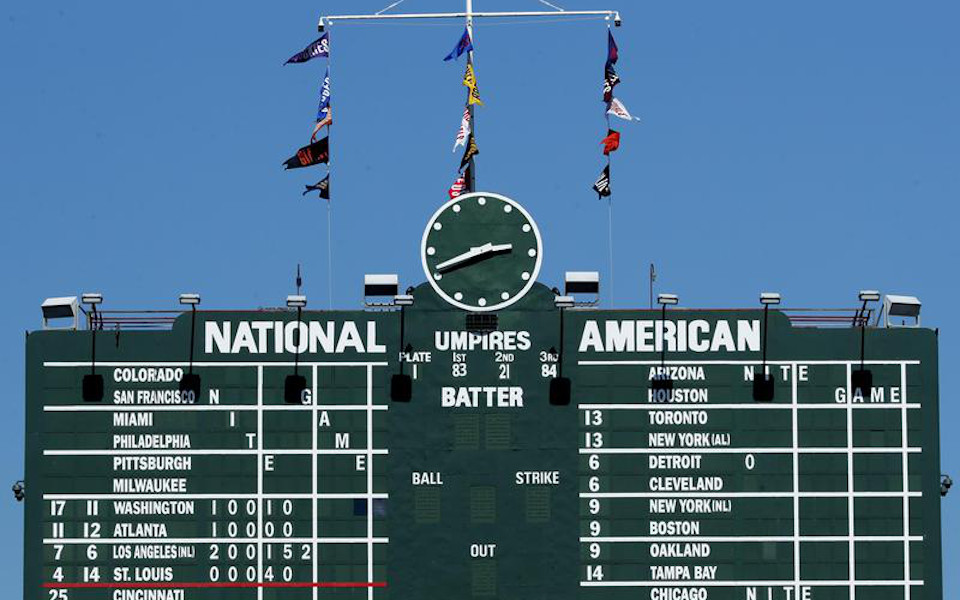
Last visit: June 22, 2024
I’ve been fortunate in life.
I’ve lived in two countries and traveled to 5 continents. I saw Ayer’s Rock at sunset and Stonehenge at sunrise. Christ the Redeemer in Rio and The Pope in the Vatican. I’ve dined in Michelin 3-star restaurants; gone wine tasting in Tuscany; and enjoyed a drink at Hemingway’s favorite bars in Havana, Paris and Venice. I honeymooned in the Greek Isles, spent a New Year’s Eve on each of the four main Hawaiian Islands, and vacationed in 12 Caribbean nations. I’ve bungeed in New Zealand, snorkeled with sharks in the Bahamas, and ridden many of the fastest and tallest roller coasters on the planet. I’ve lived in a home with a backyard pool and a view of a lake on which swans frequently swim.
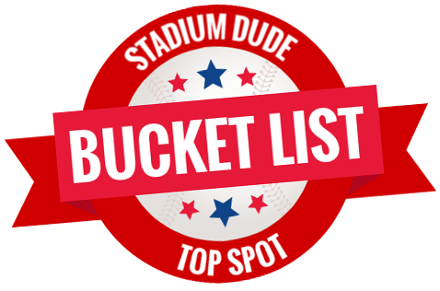
But on a nice Friday afternoon when the Chicago Cubs are in town, Wrigley Field is my favorite place on Earth.
Wrigley brings me genuine joy. The jovial atmosphere, the fan loyalty, and the timeless beauty of the brick & ivy make me happy to be alive. And I’m a curmudgeon.
My will calls for my ashes to be discretely spread here. My son’s middle name is Addison (named after Wrigley’s L-train stop). And those decisions were made BEFORE we moved to the Chicago area.
When I worked in Chicago, I managed to get to half a dozen or so Cub games a year. I’ve sat all around the park including a few times from amazing seats that were right on the first row of the Cubs dugout courtesy of my ex-employer (as an ex-client once said, “There aren’t 100 better seats in all of baseball than these.”)
I’ve witnessed the place undergo a half-billion dollar renovation. It’s made the place nicer but hasn’t taken away its timeless charm.
I’ve asked myself: “If I had one game left in life, where would I go see it?” The answer is Wrigley Field. And it’s an easy choice.
And that’s why it’s the best park in baseball.
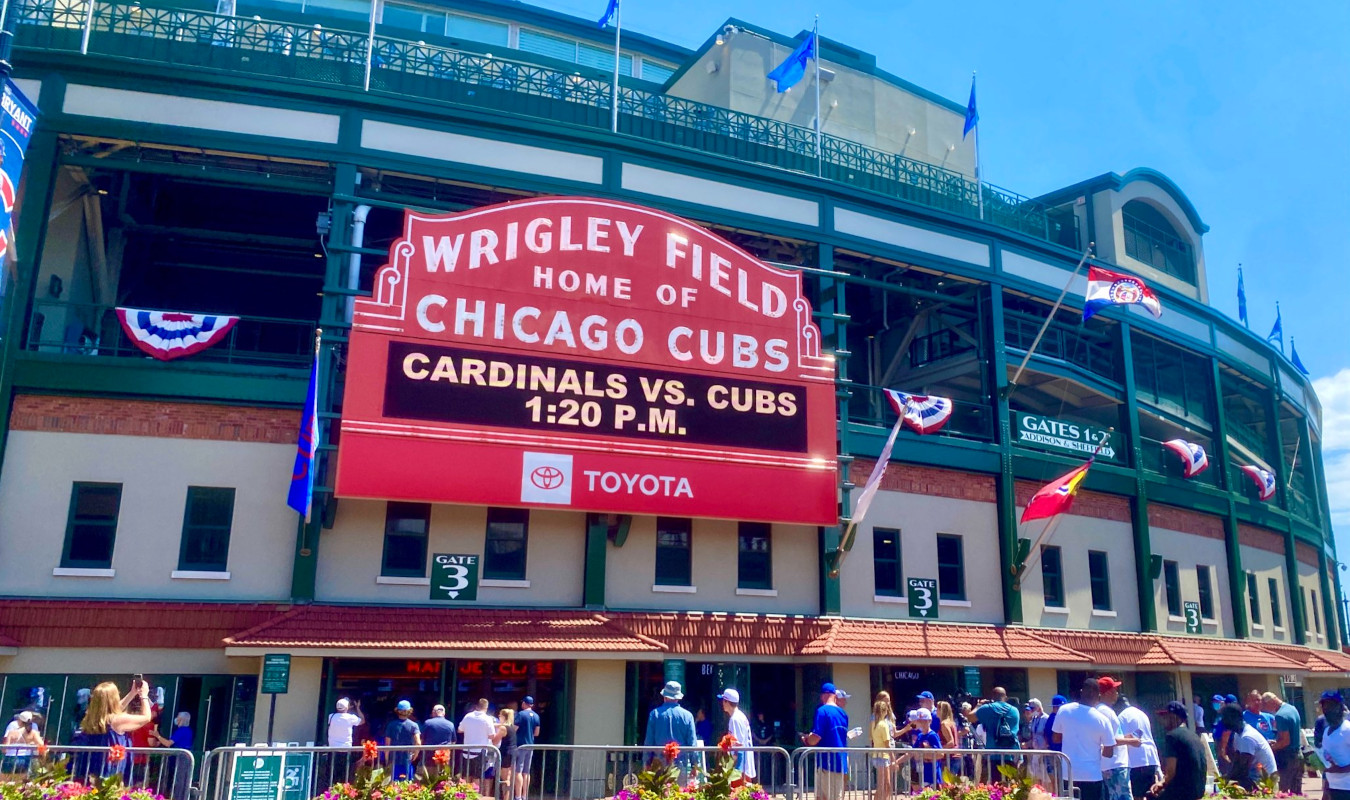
STADIUM 41.5/50
Exterior aesthetics 9/10; Interior & Concourse Aesthetics 6/10; Sightlines 2/5; Seating 3/5; Traffic flow 2/5; Scoreboard 10/10; Amenities & entertainment 3/5; Bars & Restaurants 3/5; Celebrating history 5/5; Grand entrance 5/5; Sense of place 25/25; WOW Factor 10/10. Total 83 points divided by 2 for 41.5
I’ve heard Wrigley Field be called a “novelty park” by angry White Sox fans. I’ve heard it be called a dump by people with little appreciation for history. At one point those might not have been entirely unfair criticisms, but both are moot after the renovations.
It’ll never be palatial like Yankee Stadium. Or as amenity-rich as Truist Park. Or as pristine as Petco Park. It’s just a really, really, really good baseball park.
THE GOOD:
- The ivy is iconic. The Green Monster and the B&O warehouse are fantastic, but I’d argue no single feature is more tied to a baseball park as the Wrigley Field ivy. In his youth, famous baseball showman Bill Veeck ran the marketing department for the Cubs (he likely got the gig because his dad was Cub team president). This is the same guy who sent a 3’ 7” Eddie Gaedel to hit for the Browns and greenlighted Disco Demolition Night at Comiskey Park. But his vision for the Cubs was less wacky, and arguably more enduring. He imagined Wrigley to be a a place not just for those who wanted to watch a game, but for those who wanted to soak up the very essence of summer. The Cubs ran ads in the paper during the dreary winter months with the headline “LOOK AHEAD TO SUNSHINE-RECREATION-HAPPY HOURS WITH THE CUBS AT WRIGLEY FIELD NEXT SUMMER”. When the ballpark underwent renovations before the 1937 season, along with replacing the bleachers with comfortable benches and installing the now-iconic scoreboard, Veeck planted ivy to make the park feel more like, well, a park. It’s been part of the ballpark ever since. The green on the walls and the green playing field creates this great urban oasis. As you burst through the tunnel and see the field for the first time, it’s as close to a religious experience as you can get. The park is gorgeous by any modern standards, not just because it’s old.
- The red art deco marquee sign is almost equally iconic. It’s long been Wrigley Field’s signature exterior landmark and continues to offer the ultimate photo op for first time visitors today.
- It’s cozy. Seats are close to the field. Foul territory is small and there are only two decks. I’ve watched a game from the one of the last rows in the Upper Deck seats and felt closer than when I was sitting in the first two rows of the upper deck at Sox Park.
- The scoreboards are great. The classic manual scoreboard in center was the only real scoreboard for years and conjured up all the romance of yesteryear. The Cubs finally got with the times in recent years and erected two nice videoboards, one in right and a larger one in left center. The boards admittedly change the character of the place a little but are operated very tastefully and add a whole lot more than they take away.
- The renovations restore the exterior architecture to its former look. With structural enhancements made, the ugly white concrete slabs that helped keep the park upright have been replaced by dark green galvanized steel with ornamental grill work topped with sunburst patterns. Terra cotta roofs now shade the old-timey ticket booths. It’s not over-the-top (Wrigley Field was never known for grandeur like Shibe Park, Forbes Field or even Comiskey Park), but it now looks almost as nice on the outside as it does on the inside.
- Gallagher Way is a nice addition to the outside of the park. There are a few restaurants and a large team store, but the real addition is an outdoor park accessible to all ticketed patrons, allowing Cub fans to have a few local beers, maybe play a little catch on the lawn and soak up the game day atmosphere before going into the seats. It’s Wrigley’s answer to Yawkey Way or Eutaw Street, and reminds me a little of the Braves front door at the Battery. And when the Cubs are out of town, it’s used as a French Market, an outdoor movie theatre, a music venue, and (in the winter) a place to ice skate.
- Still, after all the renovations, and expansion of seating capacity, Wrigley Field remains a neighborhood ballpark. The structure fits into the neighborhood rather than dominate it. You can’t even see the park until you’re almost literally there. While you can no longer see a game for free on a rooftop across the street (as I once did), you can still see some of the neighborhood pop out from the outfield seats.
- The rooftops have been built up. The stands atop the 3-story structures on Waveland and Sheffield cater to corporate outings with all-inclusive ticketing for larger groups. Some may complain about the commercialization of the view, but by making it a venue for group outings and cutting the Cubs in on the action, it allowed the Cubs to keep the seating bowl as is and not convert large swaths to private boxes or suites.
- The very well-heeled can enjoy a truly amazing experience in the 1914 Club, a very large underground club. Pastas, good pizzas, chef grill stations, baseball classics, desserts aplenty and alcohol are included in the crazy-high ticket price. This is one of the best club areas in Major League Baseball.
- Statues of Harry Caray, Ernie Banks, Billy Williams and Ron Santo dot the park exterior, adding some nice team history to a place that already oozes history just by standing there
- Despite its age and small footprint, the Cubs managed to find a little space for some sit down areas to accommodate fans who want a table with their meal. Larger social spaces are limited to Gallagher Way and the Draft Kings Sports Book. But the bleachers are general admission, so you can always connect and sit with your fellow bleacher bums.
- Even after a thorough modernization of the washrooms, the Cubs kept urinal troughs in the men’s rooms to help with throughput which is important given the amount of beer consumed here
THE BAD:
- Unless you have a bleacher ticket, you can’t migrate to the bleachers (though bleacher ticket holders can visit the rest of the park). This cleverly makes those outfield seats more desirable but prevents most fans from enjoying some of the better concessions that only have stands in the bleachers.
- The renovated concourses, while cleaner and shinier than I’ve ever seen them, are still cramped. Lines can still be long despite the addition of more booths. There’s really only one concourse for everyone not in the bleachers (patrons in the upper deck only have a few booths, not a full concourse) so everybody has to go to the same space. And you can’t see the field from the concourses; you need to rely on the TVs scattered throughout.
- The are no escalators to get to the upper deck. Fans need to navigate the Wrigley ramps or take one of the elevators.
- The park didn’t have lights until 1988 and wasn’t built with optimal places to install lights. As such, night games feel a little darker than at other stadiums.
- Bullpens are now out of sight underneath the bleachers meaning you need the videoboards to know who’s warming up (though is probably safer than keeping them down the lines given the lack of foul territory)
- The small footprint doesn’t allow for a dedicated kids’ area: you’ll need to play catch on Gallagher Way
- As with old-time stadiums with cantilevered decks, there are support columns to help hold up the upper deck. This means there are several obstructed view seats in the park. Also, the overhang prevents the back rows of the lower bowl (Terrace Reserved) from seeing pop ups in their entirety, but it’s way a less an issue here than it was at say, Tiger Stadium.
- If you compare it to the modern wonders, it still lacks all the amenities despite the significant improvements. But it makes up for a lot of that with charm and beauty.
Any 100+-year-old facility is bound to have flaws. Wrigley atones for them, however, in spades.

FOOD 7/10
The Cubs have done a nice job inviting local institutions into Wrigley to help bring a true taste of Chicago to what was a fairly barren food scene just a few years ago.
You can enjoy Italian Beef sandwiches. There’s a stand that sells a good Maxwell Street style porkchop sandwich. Garrett’s sells its Chicago mix popcorn (cheese and caramel corn mixed together). And you can still get an authentic Vienna Beef Chicago dog – all-beef frank on a poppy-seed bun topped with neon green relish, mustard, onions, tomato, pickle spears, 2 sport peppers and a dash of celery salt (ABSOLUTELY NO KETCHUP). That’s the superfecta of Chicago eating right there.
Other legitimate options include the the smoked brisket sandwich courtesy of local gem Lillie’s Q, a good Nashville hot chicken sandwich, bison dogs, Home Run Inn pizza, the Italian meatball sandwich, and the garlic fries. You can also get an Impossible burger, Oatly soft serve “ice cream” plus the usual baseball fare including the classic malt cup.
The real food fun, however, requires a bleacher ticket. Small Cheval burgers, the takeout offshoot of legendary burger joint Au Cheval, now has a stand in center field. And if that’s not enough to buy an outfield ticket, encased meat legend Doug Sohn, after closing his uber-popular hot dog stand in 2014, opened a stand in the Wrigley bleachers in 2016 after the Cubs asked him. A dog from Hot Doug’s at Wrigley Field is sheer bliss and is my personal fave. He offers three sausages a game, named after lesser-known former Cubs, and changes them up. Pick the one you like and thank me later. The best one I had was the “Bill Bonham”: an atomic pork sausage with cherry marmalade and smoked gouda.
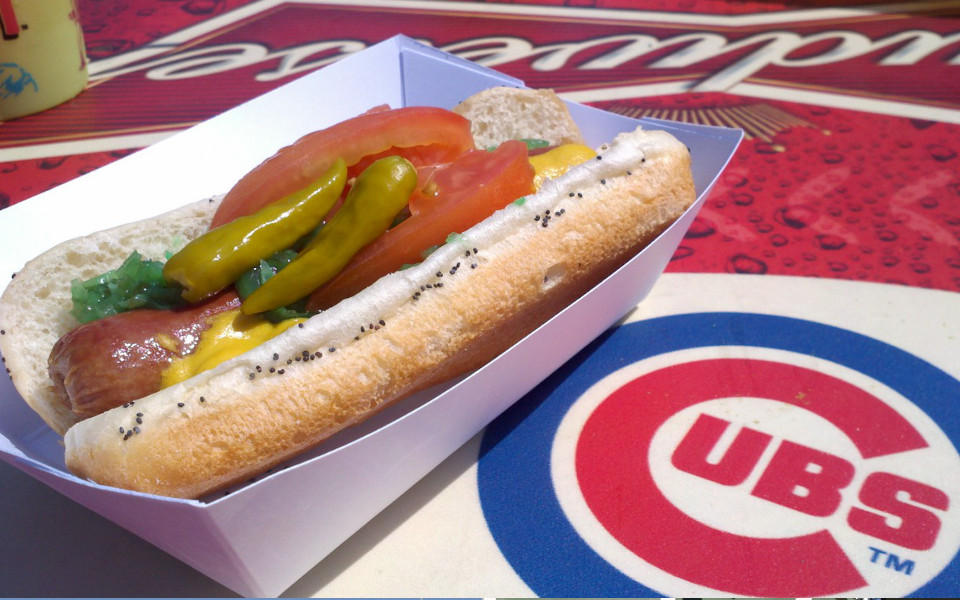
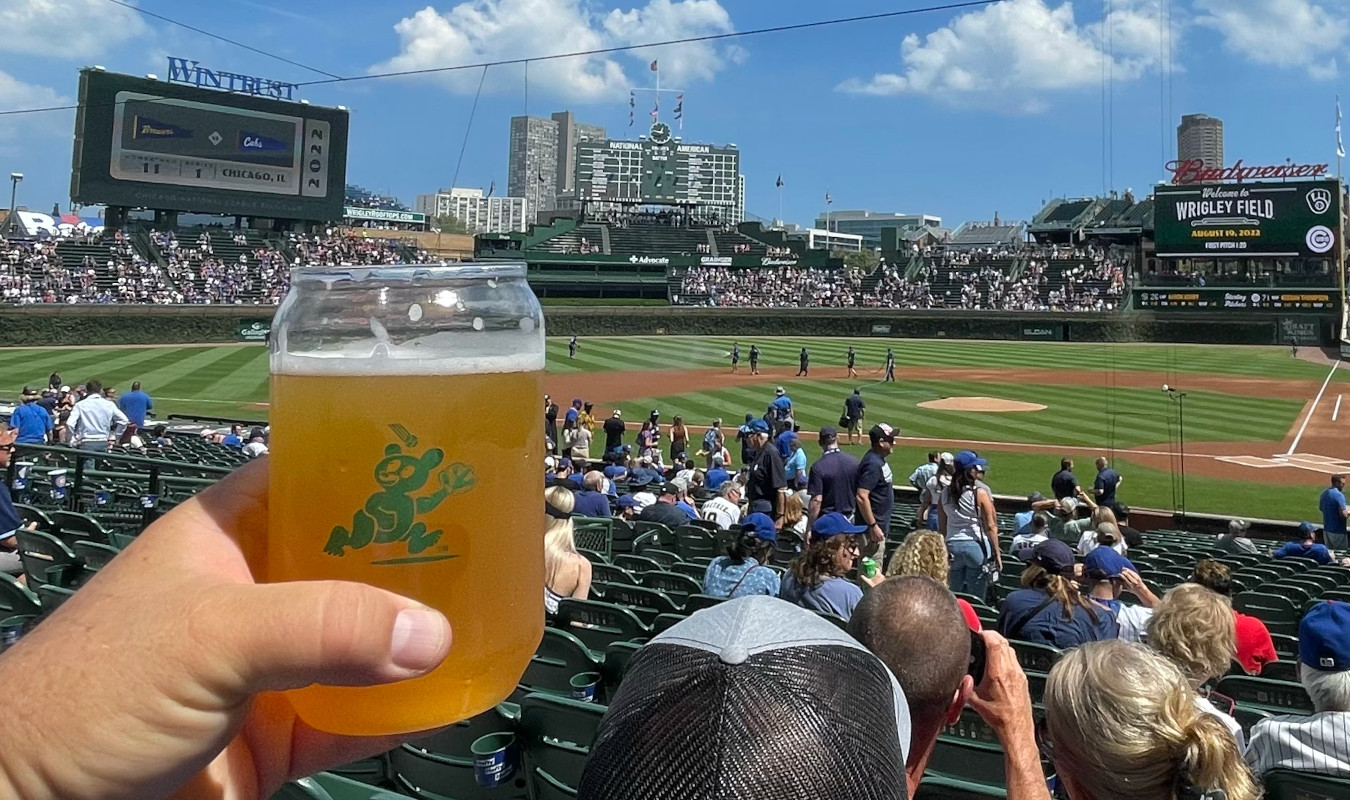
BEER 7/10
The old Cubs standby was an Old Style, a rather ordinary beer that only tasted great at Wrigley Field. Anheuser Bush then paid a bazillion dollars for the main pouring rights, and Old Style was gone (well not gone, gone. You can still get it at a few stands for old time’s sake).
Goose Island, the beloved Chicago brewer bought by AB, has a large presence here. Vendors sell the 312 and IPA, and you can get the delicious Green Line, and a few others in the concessions. And Golden Road’s Mango Cart is almost as ubiquitous as the Bud and Bud Light.
The Cubs have upped their craft beer game and now offer a strong selection of Midwestern craft beer. You can find stuff from Munster Indiana’s 3 Floyds and Kalamazoo’s Bell’s. Lagunitas, a West Coast brewer with a large Chicago brewery (thus, giving it “local cred”) has a strong presence. Chicago proper is represented by Revolution, Funkytown Brewery, and Half Acre (brewers of the amazing Daisy Cutter). I even found nice local hazy IPA from Brewer’s Kitchen.
There’s even a stand in the bleachers that sells old-timey classics like Pabst Blue Ribbon, Hamm’s and Schlitz.
Whether your taste is macro or craft, the Cubs make beer readily available with plenty of vendors and a fairly liberal policy on Last Call. Pair a few cold beers with a warm sunny day in Wrigley Field, and you have my definition of happy.
NEIGHBORHOOD 10/10
The Wrigleyville scene sets the standard for all other ballpark scenes. It’s like there are 81 block parties a year. Game Days are simply amazing. While others try to dethrone the king, it’s still the best neighborhood atmosphere in baseball.
As part of the renovations, Cubs ownership has built a hotel and restaurant space cross the street from the marquee, and populated it with some big names in Chicago’s casual dining scene. Big Star, Smoke Daddy and West Town Bakery & Tap all opened locations just outside Wrigley along with an oyster bar. Whether these places have the staying power of some of the classic establishments of the neighborhood remain to be seen. But it’s hard to beat their location.
There are over 50 other establishments in Wrigleyville, and most are hopping on game days. If you don’t like the vibe in one, you can always find another. They’re busy pre-game, post-game and sometimes, during games. Of the bars still around, I have personally visited: Cubby Bear, Sluggers, Murphy’s Bleachers, Do-Rite Donuts (home to a great hot chicken sandwich), Sheffield’s, Happy Camper, Nisei Lounge, GMan, Bernie’s, Rizzo’s Bar & Inn, Sheffield’s, Guthrie’s Tavern, Merkle’s, Vines on Clark, Lucky Dorr, Sports Corner, Bamboo Club, Lucky’s, Old Crow Smokehouse, Yak-Zies, HVAC, Moe’s Cantina, Save Ferris, and the Brickhouse Tavern. Some are dives, some are a little more swish, but all welcome baseball fans on game days.
You don’t really need a plan. Head up or down Clark, and you’ll find something that suits your fancy.
COST 1/5
Ooof. My happy place costs a lot of money. Tickets are dynamically priced and can be OK (like for an early season weekday day game against the Marlins), or Yankee-esque (like for a summer Saturday game against the Cardinals when even the “get in” price is high). Secondary market may help when the team is down, but not when the team is in contention and the place is 90%+ full. Parking also is expensive. Concessions, beer and merchandise are pretty standard.
ACCESS 3/5
If you’re staying in town, take the L. The Red Line Addison stop is literally at the park’s door stop. With an aisle seat on the first base side, I can be on the train after the game in about as much time as it takes to raise the W or L flag.
Driving prevents you from truly enjoying the scene and parking can be tricky and/or pricy unless you’re willing to walk a little (strongly advised both from a price and an ease of exit strategy). If you MUST drive, day games offer hope to save some money since street parking, if you can find it, is legal and free on many side streets nearby until 6pm; afterwards, it becomes “residents only” and you will be ticketed (read the signs carefully before parking). Night games mean paying for a lot, somebody’s driveway, or using the Cubs’ free remote lot and taking the shuttle.
WEATHER 2/5
Chicago summers are great. But April, parts of May and late September can be chilly. Rain isn’t uncommon either. And I’ve been here on humid 100-degree days with serious swamp butt. Fortunately, many seats are shaded.
VIBE 25/25
When you’re talking about your favorite place on Earth, you get a perfect score here.
Fenway’s atmosphere is one where the focus is squarely on baseball. Wrigley’s atmosphere is more festive and less angsty. There were a lot of years of futility in the 108 years between championships, and Cubs fans adapted. Wrigley became a summer party. Oh fans would still cheer as if it mattered. But there was an acceptance that the Cubs were losers, and “Win or lose, we hit the booze” was the mantra.
For years I joked the that your ticket was really just a cover charge to a 40,000-person neighborhood block party. With the exception of Cardinal games, where the mutual disdain between the fan bases made those more serious, most fans would care about the game while they were there, then quickly forget about it as they continued the festivities in the neighborhood bars. The bleachers in particular were crazy, filled with revelers, scantily clad women and a few die hards. (I’d always worry if I was sitting lower in the bleachers when a liquid came trickling down the steps in the 6th inning; I was hoping it was spilt beer, but you never knew.)
Even THEN it was still one still one of the best baseball atmospheres in the world. The place was full. Fans were happy to be there. And given the number of afternoon games, there was a decent chance you were taking a Bueller Day to be there. There was always great energy in the stands.
Things amped up significantly in the mid 2010’s as the team became a legitimate contender. The loudest outdoor baseball crowds I ever experienced were those years. And now, in a renovated place that looks nice, you can cheer loudly and not worry about being knocked out by a falling chunk of concrete.
It also has a few great traditions that make it truly special. There’s still a very active organ player adding a musical score to the game. Day games start with the Harry Simeone Songsters’ rendition of “It’s a Beautiful Day for a Ballgame” over the loudspeaker. After a Cubs win, they raise a white flag with a blue W to let those riding the Red Line know the outcome as their train passes the backside of the stadium. And post-victory, the fans all sing along to Steve Goodman’s ditty, “Go Cubs Go”; again, the audience participation is amazing. (For what it’s worth, after a loss, a blue L flag goes up, and there’s no sing along.)
But the best of the traditions is likely the 7th inning stretch, by far and away the best stretch in the game. Back in the day, fans would all get up, turn to the press box and start chanting, “Harry” for beloved drunk Harry Caray to lead the sing-along. When Harry passed, that role is now often filled with celebrities like Eddie Vedder, Bill Murray, Mike Ditka, Jim Belushi, Jon Garland, Vince Vaughn and even Cookie Monster. Sometimes they just play vintage footage of Harry Caray on the videoboard. Everybody (and I mean just about EVERYBODY) stands up, sings along, and counts out the “one, two, three strikes you’re out” before sitting down. I still get goosebumps almost every damn time.
Finally, and maybe most critically, is that Wrigley still retains its “neighborhood park” feel. Yes, there’s more advertising in the place; prices remind you it’s most certainly a Big League event; and the ushers have to enforce tickets (the downside of not having moats). But in the end, it still feels like you’re heading to the local park to watch a game. It’s the MLB park furthest from an Interstate. You have to traverse a residential area to get there. It just feels more personal. The Friendly Confines is not a stadium or a center. It’s a ballpark. Home to sunshine-recreation happy-hours.
Just like Bill Veeck wanted.
GALLERY
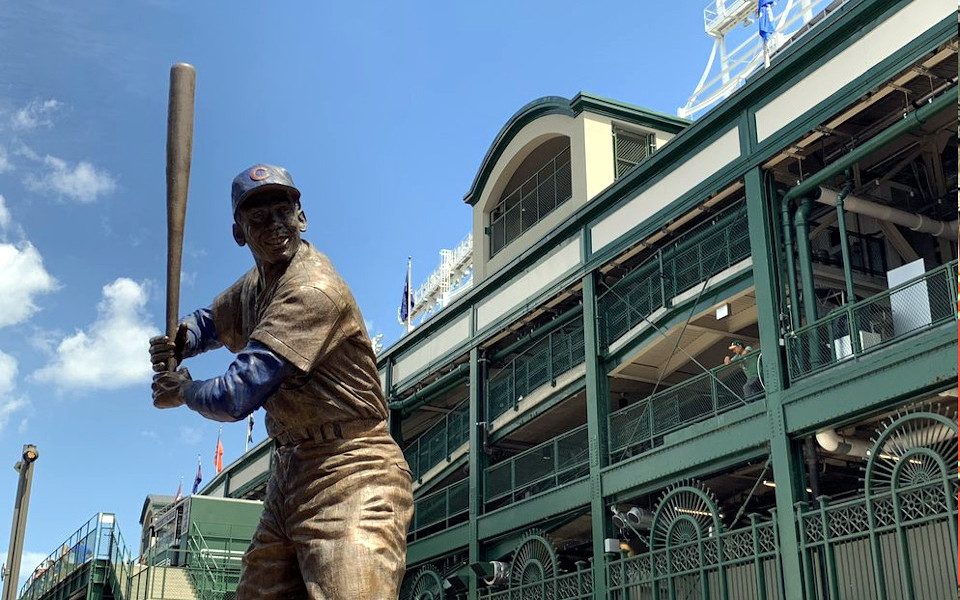
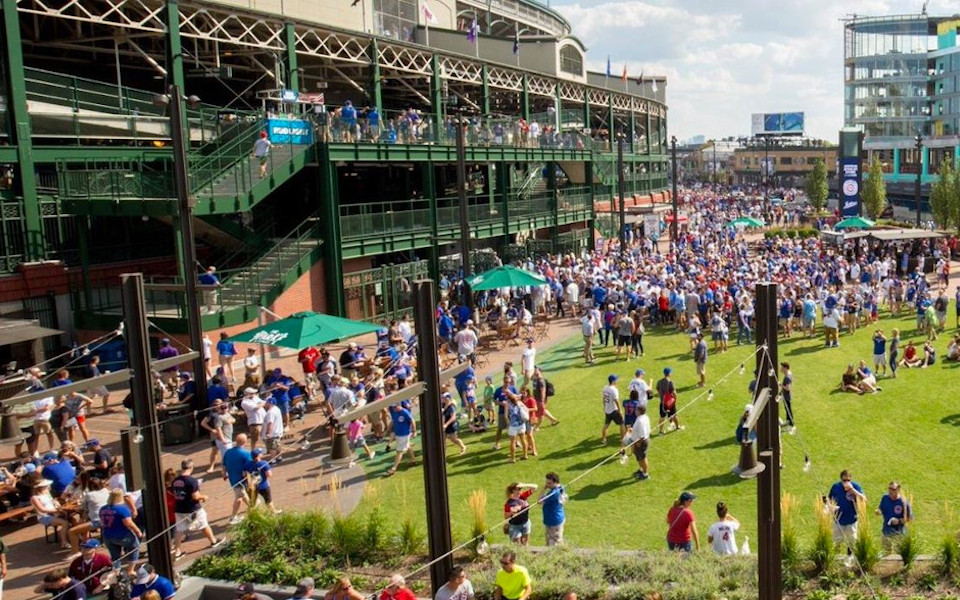
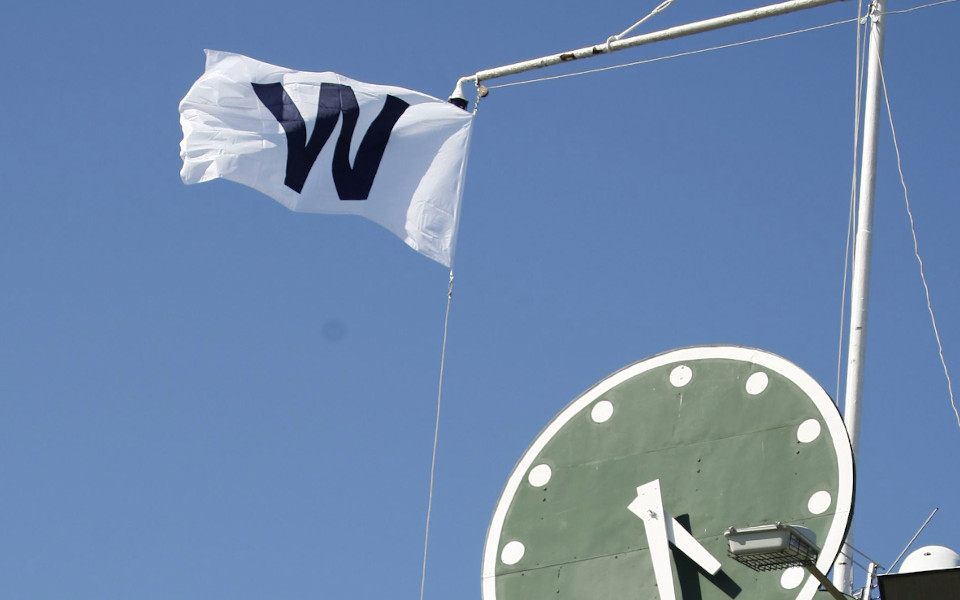
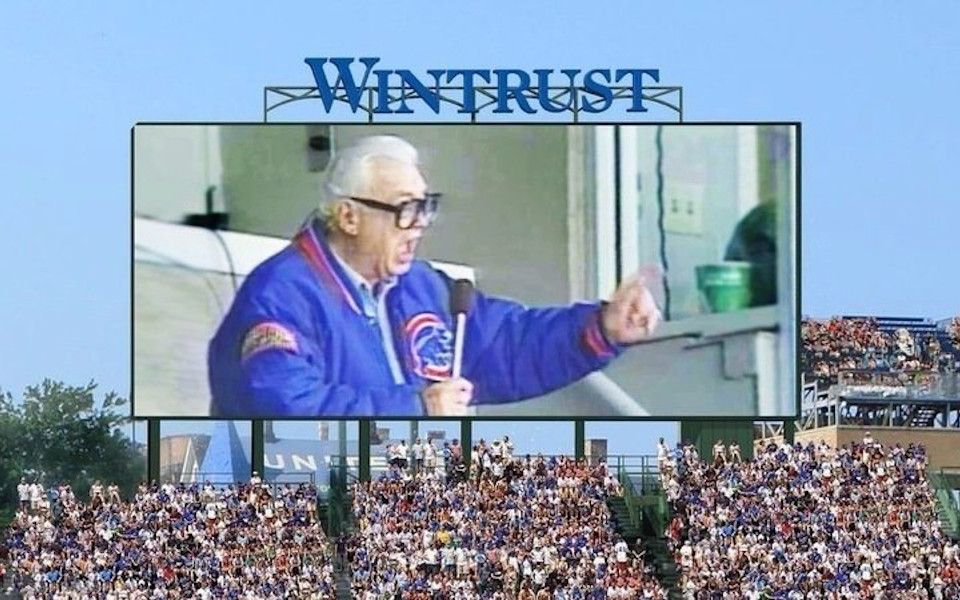
OTHER FUN THINGS TO DO
Three fun Chicago eateries:
- Au Cheval (West Loop. Upscale diner that’s home to what was once dubbed “the best burger in America” according to Daily Meal. Expect a wait.)
- Lucky’s (Wrigleyville. Small Clark Street eatery that offers sandwiches in the Primanti Bros style, i.e. meat, slaw, tomato and fries on fresh Italian bread. Great pre-game stop.)
- Pequod’s (Lincoln Park. Cited as the best pan pizza in Chicago. I agree.)
Three places to imbibe before the game:
- Sluggers (Wrigleyville. It’s a bar with, among other things, some upstairs batting cages. Because trying to hit a fastball after a few pints makes total sense)
- Murphy’s Bleachers (Wrigleyville. Bar right across the street from the bleachers. Genuine Chicago vibe.)
- Guthrie’s Tavern (Wrigleyville. A serious beer bar that definitively is not a sports bar. Caters to neighbors rather than Cub fans. I like it to escape the bro vibe for a bit. If you prefer keeping a more baseball-oriented theme, I’ll make my third entrant The Cubby Bear for tourists since it’s stupid fun, and Yak-zies for locals since they offer a more “classic” feel in an ever-changing neighborhood).
One bar in the area worth hitting:
Hopleaf (Andersonville. Since 1992 this refined beer bar in the north part of the city has paired great beers with very, very good food.)
Three craft breweries in the area worthy of your time:
- Half Acre Brewing (Balmoral. Home to the Daisy Cutter, a quintessential Chicago-style pale ale, and Bodum, a classic Chicago IPA)
- Off Color Brewing (Logan Square. Brews funky ales with an emphasis on farmhouse and sour styles)
- Revolution Brewing (Logan Square. Illinois’ largest craft brewer.)
- Bonus Pick #1: Dovetail Brewing (Lake View. Relatively close to Wrigley, this brewer does Old School Euro classics really well)
- Bonus Pick #2: Pipeworks Brewery. They don’t have a taproom, but they are great people, make really interesting stuff, offer samples before you buy, and are a worthy stop for a to-go order.
Three fun tourist attractions in the area:
- Millennium Park/Art Institute (Loop. See The Bean sculpture, then head over to the museum rated the nation’s #1 attraction by Tripadvisor.)
- Chicago Architecture Foundation River Cruise (Loop. The best of the boat cruises, the CAF offers a fascinating and excellent tour highlighting the amazing and varied architecture that make up the Chicago skyline.)
- Magnificent Mile/Navy Pier (River North. Ride the Ferris wheel at Navy Pier and stroll Michigan Ave. between the Chicago River and the John Hancock Center, taking sights like The Wrigley Building, The Tribune Tower and the Water Tower.)
SUMMARY
Wrigley has been one of America’s pre-eminent sports facilities for a few generations. The massive capital poured into it will hopefully ensure that it remains viable for several more.
There’s no better place to watch a game. When I’m there, I don’t care if I never get back. It’s my favorite ballpark. Heck, it’s my favorite place. In the world. Period.
